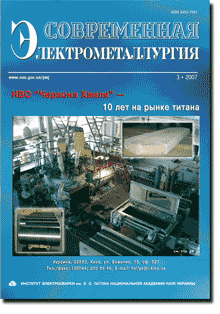| 2007 №02 | 2007 №04 |

CONTENTS

ELECTROSLAG TECHNOLOGY
Ryabtsev A.D., Davydov S.I., Troyansky A.A., Shvartsman L.Ya., Ryabtseva O.A., Pashinsky V.V. and Feofanov K.L. Production of increased strength titanium by its doping with oxygen in process of chamber electroslag remelting 2
Possibility of using oxygen-containing master alloy for controllable introduction of oxygen to titanium for the purpose of increasing its strength characteristics is shown. The method of chamber electroslag remelting of the composite consumable electrode is used.
Biktagirov F.K., Khudik B.I., Zhadkevich M.L., ProkhorenkoK.K. , Shapovalov V.A., Korostin A.D. and Muratov V.M. Production of vanadium-containing hardeners with application of electroslag techology 6
Investigations were carried out and highly efficient technology for melting by the method of silicothermic reduction in electroslag furnace from the converter vanadium slag of the vanadium-containing hardener was developed. Weight share of vanadium in the produced hardener was 17–22 % and silicon ~ 4–7 %. The degree of vanadium recovery into the metal achieved 92–95 % at residual content of V2O3 in the waste slag being up to 0.5 %.
Zhadkevich M.L., Shevtsov V.L. and Puzrin L.G. Electroslag casting with melting together. Review 11
Review of publications, concerning ESC with melting together, is made. Peculiarities of this electroslag casting method are described, and data on quality of the metal of produced billets are presented. It is shown that properties of the metal in the melting together zone are not inferior after heat treatment to those of the cast electroslag metal. Examples of successful application of this kind of electroslag casting for production of billets from different grades of steel are given. The conclusion on expediency of using ESC method with melting together under present economic conditions for manufacturing special-purpose parts of complex shape is drawn.
ELECTRON BEAM PROCESSES
Kurapov Yu.A. and Movchan B.A. Electron beam method of graphite evaporation and production of condensates free from tungsten impurities 16
Regularities of evaporation and condensation of carbon in case of its electron beam evaporation through tungsten melt under conditions of direct and reflected vapor flows are investigated. Owing to separation of the vapor flow carbon condensate without tungsten impurities was produced.
Demchenko V.F., Asnis E.A., Lesnoj A.B., Zabolotin S.P. and Shegelsky N.E. Investigation of distributed characteristics of electron beam formed by ring cathode in electron beam zone melting 19
Distribution of the electron current density on surface of a cylindrical metal specimen was investigated by the split anode method, and width of the heating zone and effective efficiency of the heat source in electron beam crucible-free zone melting were estimated.
Kostenko V.I., Pap P.A., Kalinyuk A.N., Kovalchuk D.V., Kondraty N.P. and Chernyavsky V.B. Reconstruction of electron beam installation TICO-15M 23
Experience of reconstruction of outdated electron beam melting installation with application of the latest developments in the field of electron beam engineering and technology is considered. Reconstruction of the installation with application of new gas-discharge electron guns and control system allowed mastering the new types of products, including those with increased requirements to chemical composition. The carried out works allowed increasing 2.5 times productivity of the equipment and making premises for further development.
PLASMA-ARC TECHNOLOGY
Zhadkevich M.L., Shapovalov V.A., Zhirov D.M., Melnik G.A., Prikhodko M.S. and Zhdanovsky A.A. Power parameters of process of plasma liquid-phase reduction of iron 25
Volt-ampere characteristics and gradients of voltage of arcs under conditions of plasma liquid-phase reduction of iron are determined. Dependencies of the slag-metal melt temperature upon a number of factors are revealed. Specific power, geometrical and technological parameters of melting reactors on the basis of arc steel-making and ore-smelting furnaces for plasma liquid-phase reduction of iron are suggested and optimized.
GENERAL PROBLEMS OF METALLURGY
Borisov Yu.S., Adeeva L.I., Kaplina G.S., Tunik A.Yu., Gordan G.N., Demianov I.A. and Revo S.L. Investigation of diffusion processes in multilayer composite thermal coatings 29
Processes of diffusion interaction at annealing in argon between two layers of coating, applied by the methods of plasma spraying and electric arc metallization, were investigated. The plasma coating layer was produced by spraying of the composite powder TiSi2рAl2O3рNiрCr3C2, above which a layer from aluminium alloy was applied by the method of electric arc metallization. Structure of the coating after annealing at 700 °C within 1.5 h is characterized by absence of the through porosity and increased cohesion strength, which enables increase of its resistance against gas-abrasive wear at 600 °C more than 3 times.
Tsykulenko K.A. Titanium. Problems of production. Prospects. Analytical Review. Part 3 34
Different methods of the induction and electron beam remelting of titanium and significant difficulties of production of titanium ingots by these methods are considered. Possible ways of cost reduction of the titanium products and prospects of Ukraine in the world titanium industry are shown.
ENERGY AND RESOURCE SAVING
Shejko I.V., Shapovalov V.A. and Konstantinov V.S. Alternative technologies of remelting of industrial wastes of titanium and alloys thereof 42
Data on application of the induction melting in a sectional mould for refining and disposal of the titanium and wastes thereof are presented.
INFORMATION
Prof. M.L. Zhadkevich is 70 51
Developed at PWI 10, 22, 28, 52
(You are viewing the simplified file contents)
